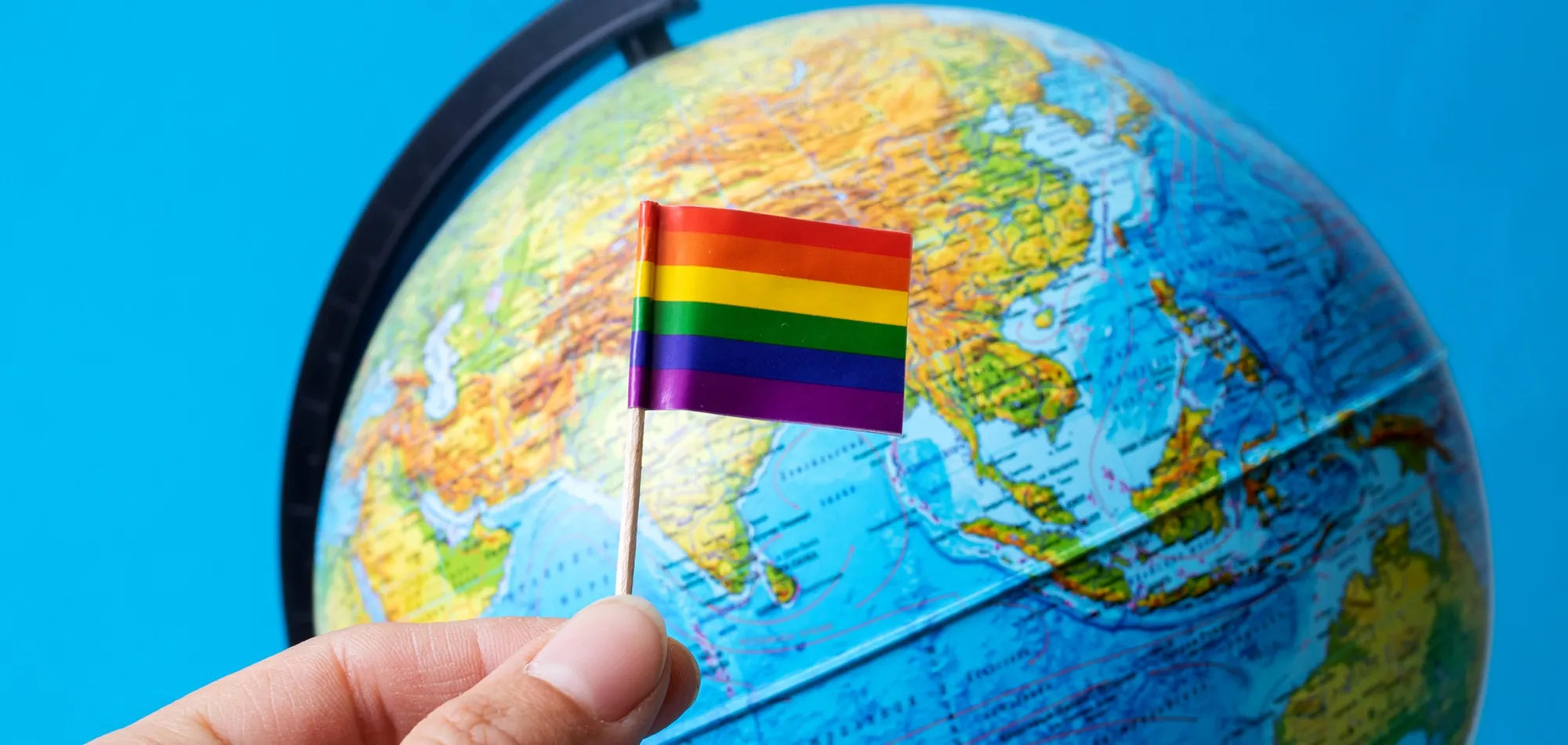NAME: Axel Strauss
DATE: 05/19/2025
Europe may be just one continent. But with roughly 50 nations, over 150 culturally distinct groups, and over 200 languages spoken — it is a diverse one in every sense of the word. So when it comes to the LGBT community, both laws and points of view vary widely. And while some nations are leading the way with full legal protections and public acceptance, others are lagging behind.
That’s why AXA — with a little help from ILGA-Europe’s Rainbow Map — has put together this simple guide below. It should help LGBTQ+ and travelers of all kinds better understand where each country stands.
- What is the Rainbow Index and How Does it Measure LGBTQ+ Equality?
- What are the top 5 LGBTQ+-friendly countries in Europe?
- LGBTQ-Friendly Travel Guide: exploring the Top 5 European countries
- What about EU and Schengen states with poor LGBTQ rights records?
- What countries are the worst for LGBTQ rights in Europe overall?
- LGBTQ-Friendly Travel in Europe: Safety Tips
What is the Rainbow Index and How Does it Measure LGBTQ+ Equality?
The Rainbow Map (aka Rainbow Index) is published annually by ILGA-Europe — aka the International Lesbian, Gay, Bisexual, Trans and Intersex Association for Europe. And it is widely considered the most comprehensive ranking system for LGBTQ+ rights on the continent.
The Rainbow Map essentially evaluates 49 European countries — including European Union nations, Schengen members, and non-Schengen countries.
And it’s based on how well their laws and policies protect and support people within the LGBTQ+ community.
Rainbow Index criteria
The 2024 Rainbow Index, for example, assessed each country across 75 different criteria — all grouped into the following seven major categories:
- Equality and non-discrimination
- Family rights
- Hate crime and hate speech laws
- Legal gender recognition
- Civil society space
- Asylum rights
- Bodily integrity and intersex rights
Rainbow Index ranking system
Each country is then assigned a score between 0% and 100%. The higher the score, the stronger the country's legal and policy framework supporting LGBTQ+ rights.
And according to ILGA-Europe, the 2024 edition has seen record highs in some countries — and worrying backslides in others.
What are the top 5 LGBTQ-friendly countries in Europe?
When it comes to LGBTQ+ rights, Europe is home to several countries that stand out for their inclusive policies, societal acceptance, and overall support for the LGBTQ+ community. And — based on the 2024 Rainbow Index above — AXA has gone ahead and compiled a list of the top 5 countries in Europe with the highest scores for LGBTQ+ rights and protection:
#1: Malta
With an impressive score of 87.84%, Malta is ranked as the most LGBTQ+-friendly country in Europe (and has been since 2015). Known for its groundbreaking legislation, Malta legalized same-sex marriage in 2017 and has one of the most progressive frameworks for LGBTQ+ rights.
The tiny country’s diverse, welcoming atmosphere makes it a top destination for LGBTQ+ travelers — offering vibrant Pride celebrations, a rich cultural heritage, and perfect weather year-round.
#2: Iceland
Iceland takes the second spot on the list — with a score of 83.03%. The fellow island nation — although generally much chillier — has long been a pioneer in LGBTQ+ rights as well. In fact, Iceland was one of the first countries to elect an openly gay prime minister.
Its capital Reykjavik — where LGBTQ+ visitors can enjoy a range of inclusive activities and the famous Reykjavik Pride festival — offers an especially safe and inclusive environment.
#3: Belgium
The third spot on the list takes us back to mainland Europe, where Belgium scores 78.48%. Another world leader in LGBTQ+ rights, Belgium legalized same-sex marriage in 2003.
And with comprehensive anti-discrimination laws and a thriving LGBTQ+ community — particularly in cities like Brussels and Antwerp — Belgium continues to provide a welcoming environment for both LGBTQ+ locals and travelers from all over the world.
#4: Spain
Relatively nearby Spain ranks fourth with a score of 76.41%. Known worldwide for its vibrant LGBTQ+ scene, Spain legalized same-sex marriage in 2005 — also making it one of the first countries in Europe to do so.
Madrid and Barcelona are particularly popular LGBTQ+ destinations — offering dynamic cultural hubs and events, Pride celebrations, and a strong sense of inclusivity.
#5: Denmark
And rounding out the top five — with a score of 76.35% — we head back north to Denmark. Having legalized same-sex marriage in 2012, Denmark has been a trailblazer for LGBTQ+ rights in Europe for decades.
And that’s not just its capital of Copenhagen — as the vast majority of the country has long been renowned for its vibrant atmosphere and progressive attitudes toward LGBTQ+ equality.
LGBTQ-Friendly Travel Guide: Exploring the Top 5 European Countries
And along with ranking the top five, AXA has also compiled a few tips on the best places to visit, events to attend, and some fun facts about each of Europe’s top five LGBTQ+ friendly countries too!
PRO-TIP: And don’t forget that if you're coming from outside the EU, you might need a Schengen visa (as well as the mandatory Schengen travel insurance to match). In which case, fear not — because AXA’s got your back too (more on that below).
So without further ado, here are five bite-sized travel guides to help you make the most of your trip:
Malta: LGBTQ-Friendly destination
Best season to go there: Spring (April–June) — perfect weather and fewer crowds.
3 must-see places:
- Valletta’s Strait Street — once infamous, now LGBTQ+-chic
- Mdina’s medieval alleys — for some unique culture and history.
- Gozo — the perfect island for a relaxed escape.
One event not to miss: Malta International Arts Festival (MIAF)— not LGBTQ-only, but artsy, open, and with a strong queer presence.
Fun fact: Malta is the only country to score 100% in ILGA’s Trans Rights category (2024).
PRO-TIPS: AXA can help you secure both a Schengen visa for Malta and Malta travel insurance.
Iceland: LGBTQ-Friendly destination
Best season to go there: Summer (June–August) — endless daylight and festival energy.
3 must-see places:
- Reykjavik’s Laugavegur Street — the heart of queer nightlife, with world-famous spots like Kiki.
- The Blue Lagoon — iconic and soothing, with inclusive vibes.
- Þingvellir National Park — a surreal mix of geology and Icelandic history.
One event not to miss: Rainbow Reykjavik Winter Pride — spa parties, aurora-chasing, and LGBTQ+ culture galore.
Fun fact: Iceland’s former PM Jóhanna Sigurðardóttir was the world’s first openly gay head of government.
PRO-TIPS: AXA can help you get a Schengen visa for Iceland and Iceland travel insurance too.
Belgium: LGBTQ-Friendly destination
Best season to go there: Late spring (May–early June) — mild weather and lively streets.
3 must-see places:
- Brussels’ Saint-Jacques district — the city's LGBTQ+ core.
- Ghent’s canals — charming, walkable, and a hidden gem.
- Antwerp’s fashion quarter — edgy, stylish, and queer-friendly.
One event not to miss: Belgian Pride in Brussels (mid-May) — politically conscious and joyfully inclusive.
Fun fact: Belgium legalized same-sex marriage back in 2003 — second in the world.
PRO-TIPS: Yep, we can help you with that Schengen visa for Belgium — and the best Belgian travel insurance for it — as well.
Spain: LGBTQ-Friendly destination
Best season to go there: Early autumn (September–October) — sunny, vibrant, and way less crowded.
3 must-see places:
- Madrid’s Chueca neighborhood — LGBTQ+ central with non-stop energy.
- Sitges — a dreamy coastal town with major queer appeal.
- Granada’s Alhambra — stunning architecture, inclusive spirit, and sometimes even ranked the eighth wonder of the world (PRO-TIP: Get your tix way in advance though!).
One event not to miss: LesGaiCineMad — one of Europe’s top LGBTQ+ film festivals, held in Madrid each November.
Fun fact: Although fourth on the Rainbow map Spain, according to the Pew Research Center, Spain was #1 in Europe for LGBTQ+ social acceptance in 2023.
PRO-TIPS: Learn about Spain’s #1 mandatory travel insurance — whether you need a Spanish Schengen visa or not!
Denmark: : LGBTQ-Friendly destination
Best season to go there: Summer (June–August) — when hygge meets high-energy events.
3 must-see places:
- Copenhagen’s Vesterbro district — hip, diverse, and LGBTQ-welcoming.
- Aarhus’ waterfront — artsy and laid-back, with queer-friendly cafés.
- Christiania — an experimental enclave of a neighborhood with an open, alternative spirit.
One event not to miss: Copenhagen Winter Pride — warm drag shows, bold talks, and strong community vibes in the winter chill (PRO-TIP: The Danish winter chill is no joke though — so pack accordingly!).
Fun fact: Denmark was the first country to legally recognize same-sex unions — way back in 1989.
PRO-TIPS: Schengen visa for Denmark? Denmark travel insurance? As always, AXA got your back.
What about EU and Schengen states with poor LGBTQ+ rights records?
While the EU generally champions human rights, a few of its members still fall behind on LGBTQ+ protections. So here are also the lowest-ranked countries — within the EU or Schengen Area, that is — according to ILGA-Europe's 2024 Rainbow Map.
PRO-TIPS: And keep in mind that even for low-Rainbow-map-ranked EU and Schengen states, AXA still offers both visa support and travel insurance. So if you’re planning a trip to one of them — explore your options below too.
Poland
With a score of 18.46%, Poland’s conservative politics, “LGBT-free zones,” and limited protections continue to harm community well-being.
For more travel information: Schengen visa for Poland and Poland Travel Insurance.
Romania
A newly joined Schengen state, Romania ranks not much higher than Poland — with 18.78%. Same-sex couples lack recognition, and progress remains stalled — despite EU pressure.
For more travel information: Schengen visa for Romania (and its requirements) and Travel Insurance for Romania
Bulgaria
And also recent Schengen addition Bulgaria ranks third lowest (again, within the Schengen and/or EU) — with 22.58%. No legal protection for same-sex couples, weak anti-discrimination laws, and social stigma persist.
For more travel information: Schengen visa for Bulgaria and Bulgaria Travel Insurance.
What countries are the worst for LGBTQ Rights in Europe overall?
And looking beyond the EU and Schengen, several European countries unfortunately remain openly hostile and/or legally unsafe for LGBTQ+ people. Here are the lowest three countries ranked in the Rainbow Map (when it comes to all of Europe):
Russia (2.33%)
Severe anti-LGBTQ laws, propaganda bans, and recent crackdowns make it one of the most dangerous places in Europe for queer travelers.
Azerbaijan (2.33%)
LGBTQ+ people face police violence, extortion, and zero protections in law.
Turkey (5.12%)
Pride events banned or violently suppressed, with growing state hostility toward queer visibility.
LGBTQ+-Friendly Travel in Europe: Safety Tips
So, to sum up, Europe is pretty queer-friendly overall — especially its more western nations. Nevertheless, a wise traveler always stays prepped for anything. So, fortunately, we’ve also got a few final safety tips — and some things to keep in mind — for your upcoming European adventure:
Understand local LGBTQ+ laws and customs
As evidenced by the Rainbow Map and all its findings, both legal protections and social factors differ greatly from country to country. Public displays of affection might be accepted in some places, for example, but frowned upon — or even dangerous — in others. So always investigate both the legal and cultural local landscape before you go.
Travel with accurate documentation
Trans and non-binary travelers should ensure their documents match the name and gender marker used for travel. If there are discrepancies, carry supporting documents or a medical letter to avoid unnecessary delays or issues at border controls.
Choose verified LGBTQ+-friendly accommodations
Look for hotels, hostels, or rentals that are reviewed positively by LGBTQ+ guests or listed as inclusive by verified platforms. This can enhance comfort and avoid awkward or discriminatory encounters.
Download safety and communication tools
The internet has countless LGBTQ+-friendly resources to help keep the growing community safe.
For example, apps like Equaldex provide real-time safety insights — including LGBTQ+ rights info — by country. Meanwhile, secure messaging apps like Signal can provide a little added privacy if need be.
Connect with local LGBTQ+ organizations
European national and city-based LGBTQ+ rights groups often post the most up-to-date info on safety, events, and local news as well. So following their social media pages can help you stay both informed and safe while traveling.
Get insured (aka FINAL PRO-TIP)
Having comprehensive travel insurance that covers unexpected medical care, lost luggage, visa-related issues, and more can prove essential for a safer trip for anyone.
So before you book that ticket and zip that suitcase, why not
and
get a free AXA quote too?
After all, no matter where on the Rainbow Map you end up, with AXA your trip is guaranteed to be that much more worry-free — regardless of orientation, identity, or politics.
RELATED ARTICLES:
- Explore this year’s European Capitals of Culture
- Tourist attractions to avoid in Europe and what to do instead
- Safety tips when traveling to Europe
FAQ
Are there any European countries where LGBTQ+ people face real legal risks?
Yes. For example, in Hungary, Poland, and Russia, laws restrict LGBTQ rights — from “anti-propaganda” rules to limited protections. So research ahead of time, and be cautious — especially outside big cities.
Which European countries still have no recognition of same-sex relationships?
Armenia, Belarus, Georgia, Moldova, Russia, Serbia, and Ukraine still neither recognize nor allow same sex marriage or civil unions. As well as EU and Schengen member states like Bulgaria, Lithuania, Latvia, Poland, Romania, and Slovakia. And while travel to some of these is safer than others, legal protections there remain limited.
Is Pride legal everywhere?
No. In places like Turkey, Russia, and parts of the Balkans, Pride events are banned and/or often disrupted. So use caution and always check local updates if you plan to attend.
AXA already looks after millions of people around the world
With our travel insurance we can take great care of you too
AXA Schengen's Travel Insurances

AXA Schengen Basic
AXA Schengen Basic is perfect to obtain your Schengen visa. This travel insurance meets all the requirements demanded, covers you in all the countries of the Schengen Area as well as 4 European microstates (Andorra, Vatican City, Monaco and San Marino).

AXA Schengen Essential
AXA Essential is perfect to obtain your Schengen visa. It provides coverage in all the Schengen countries + the European microstates + all the EU countries (including UK, Cyprus and the Republic of Ireland). And you get additional guarantees compared to AXA Schengen Basic.

AXA Schengen Annual
AXA Annual is perfect to obtain your Schengen visa. This annual travel insurance is ideal for those who often travel to Europe as well as multiple-entry Schengen visa holders. You get the same guarantees as AXA Schengen Annual for different countries during 90 days.


